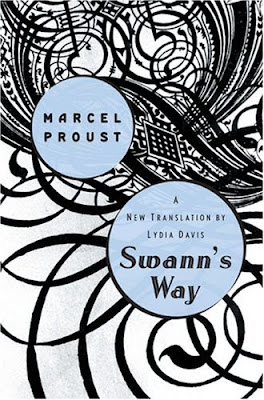Book Review: In Search of Lost Time: Swann’s Way
by David Blake, Fiction Department, Central Library
In Search of Lost Time: Swann’s Way
Marcel Proust
Translated by Lydia Davis
When first considering Marcel Proust’s masterpiece, the reader must choose from among several well-regarded translations. The English translation by C. K. Scott Moncrieff in the 1920s, with its famous title Remembrance of Things Past, is still widely admired, and has been updated by several respectful translators since. But this reader chose the recent, wholly new translation called In Search of Lost Time, with different translators for each of the seven volumes of this monumental novel. The translation of Swann’s Way, the first volume, by Lydia Davis, simple and clean, is in no way disappointing.
In Search of Lost Time is a mythical Mount Everest for the serious reader, a daunting challenge that promises pride of accomplishment and wide new aesthetic vistas. Nonetheless, it is seven books, each with a finite number of pages. The challenge for the reader is how to move forward when one is so dazzled by the prose of a single paragraph. We rely on narrative and plot devices to move us forward as we read most books, but Swann’s Way has fewer of these incentives than the usual short story. A sickly boy suffers debilitating separation anxiety every night waiting for his mother’s goodnight kiss, a cultured man’s mistress treats him cruelly, the sickly boy suffers unrequited infatuation for a girl with whom he plays in the parks of the Champs-Elysees. The places these characters inhabit and the agony of their inner lives are rendered with the precision and pity we might attribute to an omniscient loving deity.
The narrator tells the boy’s story, in the first person, with the elegiac tone of a mature man looking back on times and places that exist only in memory. The iconic scene wherein the narrator dips a madeleine (cookie) into his tea triggering vivid unbidden memories occurs early on in Swann’s Way. The smell and the taste of the tea-soaked madeleine unlock recollections of flowers and of divergent country paths traveled in the narrator’s youth. One path, called Swann’s Way, leads past the estate of a family friend, Charles Swann, who is caught up in the decadent demimonde of Belle Epoque Paris. The other path skirts the gardens of the Guermantes, an ancient noble family at the pinnacle of elegant aristocratic society. Symbolically, these paths will define the narrator’s stories throughout In Search of Lost Time.
One reads In Search of Lost Time for the beauty of the language. Wondrous metaphors pile up upon each other in sentence after sentence, as do Proust’s incisive observations on human longing, jealousy, and loss. After hours of reading Swann’s Way, decoding the language, readers might feel as if they had spent an afternoon performing differential equations. But, the residue, at the bottom of the tea cup, as it were, is art.
Oh, and by the way, Marcel Proust is really funny.
Marcel Proust
Translated by Lydia Davis
When first considering Marcel Proust’s masterpiece, the reader must choose from among several well-regarded translations. The English translation by C. K. Scott Moncrieff in the 1920s, with its famous title Remembrance of Things Past, is still widely admired, and has been updated by several respectful translators since. But this reader chose the recent, wholly new translation called In Search of Lost Time, with different translators for each of the seven volumes of this monumental novel. The translation of Swann’s Way, the first volume, by Lydia Davis, simple and clean, is in no way disappointing.
In Search of Lost Time is a mythical Mount Everest for the serious reader, a daunting challenge that promises pride of accomplishment and wide new aesthetic vistas. Nonetheless, it is seven books, each with a finite number of pages. The challenge for the reader is how to move forward when one is so dazzled by the prose of a single paragraph. We rely on narrative and plot devices to move us forward as we read most books, but Swann’s Way has fewer of these incentives than the usual short story. A sickly boy suffers debilitating separation anxiety every night waiting for his mother’s goodnight kiss, a cultured man’s mistress treats him cruelly, the sickly boy suffers unrequited infatuation for a girl with whom he plays in the parks of the Champs-Elysees. The places these characters inhabit and the agony of their inner lives are rendered with the precision and pity we might attribute to an omniscient loving deity.
The narrator tells the boy’s story, in the first person, with the elegiac tone of a mature man looking back on times and places that exist only in memory. The iconic scene wherein the narrator dips a madeleine (cookie) into his tea triggering vivid unbidden memories occurs early on in Swann’s Way. The smell and the taste of the tea-soaked madeleine unlock recollections of flowers and of divergent country paths traveled in the narrator’s youth. One path, called Swann’s Way, leads past the estate of a family friend, Charles Swann, who is caught up in the decadent demimonde of Belle Epoque Paris. The other path skirts the gardens of the Guermantes, an ancient noble family at the pinnacle of elegant aristocratic society. Symbolically, these paths will define the narrator’s stories throughout In Search of Lost Time.
One reads In Search of Lost Time for the beauty of the language. Wondrous metaphors pile up upon each other in sentence after sentence, as do Proust’s incisive observations on human longing, jealousy, and loss. After hours of reading Swann’s Way, decoding the language, readers might feel as if they had spent an afternoon performing differential equations. But, the residue, at the bottom of the tea cup, as it were, is art.
Oh, and by the way, Marcel Proust is really funny.

Comments